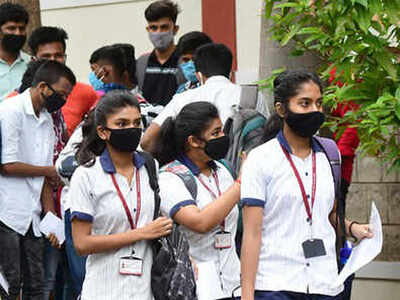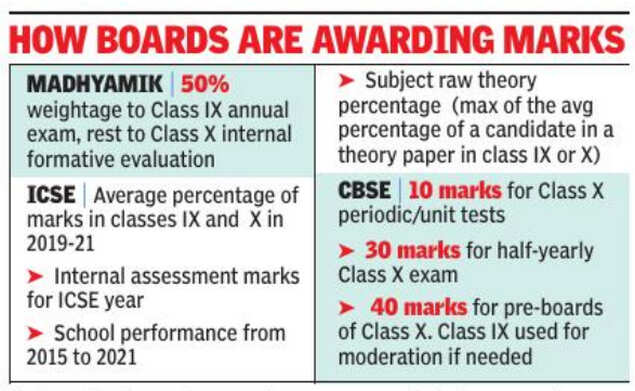Top Searches
- News
- City News
- kolkata News
- West Bengal: 100% success, 79 toppers in Covid-year Madhyamik
West Bengal: 100% success, 79 toppers in Covid-year Madhyamik

Image used for representational purpose only
KOLKATA: The results of this year’s Madhyamik examination — cancelled because of the pandemic — have thrown up several firsts: a cent-percent pass rate among 10,79,749 candidates; as many as 90% candidates with over-60% marks; an unprecedented number of them — 79 — sharing the top rank, having received 697 out of 700 marks; and over 1,000 students in the top-10 merit list.
But not all educationists are commensurately happy. The big question is, what happens if HS marks, too, follow the Madhyamik trend?

No formal merit list has been issued. The results were prepared based on annual examinations of Class IX and an “internal formative evaluation” of Class X performance. Board president Kalyanmoy Ganguly said merit had been taken into account by integrating past performances.
There was a remarkable performance jump in all subjects. Three to four times as many candidates scored more than 90% in each subject, translating to an increase of 200% to 300% from previous year. Only in mathematics, the number — with a 30% jump — looks modest by comparison.
To put things in perspective, last year, 135 Higher Secondary candidates had occupied the top-10 position, said an education department source, adding that was the highest number ever, whether Madhyamik or HS. “We have never had any joint first rank-holder in Madhyamik, though there have been multiple rank-holders in other positions,” said Saugata Basu, general secretary of the West Bengal Government Teachers’ Association.
In the evening, the West Bengal Council of Higher Secondary Education issued a notification, revising the minimum marks for studying various subjects in Class XI from 34% to 45%. Sources said the notification was indicative of how much marks had increased this year. Under this notification, a student would have to score 45% in mathematics to study mathematics, statistics or computer science as an elective subject in Class XI. Similarly, a student has to score 45% in life science to take up biological sciences; 45% in physical sciences to take up physics or chemistry or both; and 45% in geography to study geography.
A number of educationists and principals expressed concern. What happens if the Higher Secondary results, too, reflect a similar trend? Not only would that make it challenging for meritorious students of other boards to secure college admissions, in the absence of admission tests or interviews, it would be detrimental to the students’ future prospects, as many students could opt for wrong subjects in undergraduate courses, in the absence of an objective assessment of one’s aptitude, the experts felt.
Not that each of the 42,855 students who have scored above 90% are experiencing unalloyed joy. Many of them are a little circumspect, and feel they would have been happier had they scored as many marks, or even a little fewer, but in a written exam.
While students in Kolkata fared well, the districts edged out the city from the top spot, in keeping with the trend of the past several years. The highest numbers came in from South 24 Parganas, where 55,471 girls and 42,735 boys registered for the exam. From Kolkata, 13,850 girls and 12,067 boys had registered.
A number of city principals were unhappy despite the overall high marks, saying the results did not match their expectation. “When there is no external written exam and when marks are drawn up like this, there is not much to expect. However, our boys could have done better,” said Jayanta Bhattacharya, headmaster of Hare School. The topper of this school has scored 635.
Parimal Bhattacharya, headmaster of Jadavpur Vidyapith, was happy that the topper of his school had scored 687. “This was the kind of highest score I was expecting,” he said. With a score of 655, the topper from Ballygunj Shiksha Sadan expressed happiness. “I had expected perhaps five marks more but, without a written exam, this was the best that could happen,” she said.
The contrast with last year’s Madyamik, when written exams were held, is startling. The pass percentage was 86.34% last year, with the topper scoring 694. Candidates were able to log into 12 designated websites from 10am, type in their date of birth and registration numbers to get their results. Many also used the SMS option. Schools were able to collect their mark sheets from 49 designated centres of the board from 10am. Students were also able to access mark sheets through parents, who went to the respective schools.
— With inputs from Somdatta Basu
But not all educationists are commensurately happy. The big question is, what happens if HS marks, too, follow the Madhyamik trend?

No formal merit list has been issued. The results were prepared based on annual examinations of Class IX and an “internal formative evaluation” of Class X performance. Board president Kalyanmoy Ganguly said merit had been taken into account by integrating past performances.
There was a remarkable performance jump in all subjects. Three to four times as many candidates scored more than 90% in each subject, translating to an increase of 200% to 300% from previous year. Only in mathematics, the number — with a 30% jump — looks modest by comparison.
To put things in perspective, last year, 135 Higher Secondary candidates had occupied the top-10 position, said an education department source, adding that was the highest number ever, whether Madhyamik or HS. “We have never had any joint first rank-holder in Madhyamik, though there have been multiple rank-holders in other positions,” said Saugata Basu, general secretary of the West Bengal Government Teachers’ Association.
In the evening, the West Bengal Council of Higher Secondary Education issued a notification, revising the minimum marks for studying various subjects in Class XI from 34% to 45%. Sources said the notification was indicative of how much marks had increased this year. Under this notification, a student would have to score 45% in mathematics to study mathematics, statistics or computer science as an elective subject in Class XI. Similarly, a student has to score 45% in life science to take up biological sciences; 45% in physical sciences to take up physics or chemistry or both; and 45% in geography to study geography.
A number of educationists and principals expressed concern. What happens if the Higher Secondary results, too, reflect a similar trend? Not only would that make it challenging for meritorious students of other boards to secure college admissions, in the absence of admission tests or interviews, it would be detrimental to the students’ future prospects, as many students could opt for wrong subjects in undergraduate courses, in the absence of an objective assessment of one’s aptitude, the experts felt.
Not that each of the 42,855 students who have scored above 90% are experiencing unalloyed joy. Many of them are a little circumspect, and feel they would have been happier had they scored as many marks, or even a little fewer, but in a written exam.
While students in Kolkata fared well, the districts edged out the city from the top spot, in keeping with the trend of the past several years. The highest numbers came in from South 24 Parganas, where 55,471 girls and 42,735 boys registered for the exam. From Kolkata, 13,850 girls and 12,067 boys had registered.
A number of city principals were unhappy despite the overall high marks, saying the results did not match their expectation. “When there is no external written exam and when marks are drawn up like this, there is not much to expect. However, our boys could have done better,” said Jayanta Bhattacharya, headmaster of Hare School. The topper of this school has scored 635.
Parimal Bhattacharya, headmaster of Jadavpur Vidyapith, was happy that the topper of his school had scored 687. “This was the kind of highest score I was expecting,” he said. With a score of 655, the topper from Ballygunj Shiksha Sadan expressed happiness. “I had expected perhaps five marks more but, without a written exam, this was the best that could happen,” she said.
The contrast with last year’s Madyamik, when written exams were held, is startling. The pass percentage was 86.34% last year, with the topper scoring 694. Candidates were able to log into 12 designated websites from 10am, type in their date of birth and registration numbers to get their results. Many also used the SMS option. Schools were able to collect their mark sheets from 49 designated centres of the board from 10am. Students were also able to access mark sheets through parents, who went to the respective schools.
— With inputs from Somdatta Basu
FacebookTwitterLinkedinEMail
Start a Conversation
end of article
